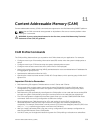
11
Content Addressable Memory (CAM)
Content addressable memory (CAM) commands are supported on the Dell Networking S4820T platform.
NOTE: Not all CAM commands are supported on all platforms. Be sure to note the platform when
looking for a command.
WARNING: If you are using these features for the first time, contact Dell Networking Technical
Assistance Center (TAC) for guidance.
CAM Profile Commands
The CAM profiling feature allows you to partition the CAM to best suit your application. For example:
• Configure more Layer 2 forwarding information base (FIB) entries when the system is deployed as a
switch.
• Configure more Layer 3 FIB entries when the system is deployed as a router.
• Configure more access control lists (ACLs) (when IPv6 is not employed).
• Hash multi-protocol label switching (MPLS) packets based on source and destination IP addresses for
link aggregation groups (LAGs).
• Hash based on bidirectional flow for LAGs.
• Optimize the virtual local area network (VLAN) ACL Group feature, which permits group VLANs for IP
egress ACLs.
Important Points to Remember
• Dell Networking OS supports CAM allocations on the C-Series and S-Series.
• All line cards within a single system must have the same CAM profile (including CAM sub-region
configurations); this profile must match the system CAM profile (the profile on the primary route
processor module [RPM]).
• Dell Networking OS automatically reconfigures the CAM profile on line cards and the secondary RPM
to match the system CAM profile by saving the correct profile on the card and then rebooting it.
• The CAM configuration is applied to the entire system when you use the CONFIGURATION mode
commands. Save the running-configuration to affect the change.
• When budgeting your CAM allocations for ACLs and quality of service (QoS) configurations,
remember that ACL and QoS rules might consume more than one CAM entry depending on
complexity. For example, transmission control protocol (TCP) and user datagram protocol (UDP) rules
with port range options might require more than one CAM entry.
• After you install a secondary RPM, copy the running-configuration to the startup-configuration so
that the new RPM has the correct CAM profile.
• You MUST save your changes and reboot the system for CAM profiling or allocations to take effect.
Content Addressable Memory (CAM)
539


















